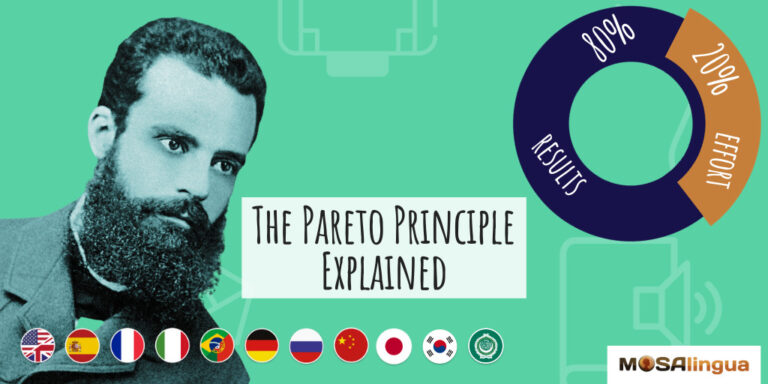Are you familiar with the Pareto principle? It’s a concept that has applications in numerous domains, and languages are no exception! In fact, the Pareto principle (also known as the 80/20 rule) is a fundamental part of the MosaLearning® language teaching method. In this article, we’ll dig a little deeper into the details behind this principle, and explain why you, as a language learner, should be interested in how it can further your language learning goals.

Origin and Idea Behind the Pareto Principle
Italy, beginning of the 20th century. Economist Vilfredo Pareto observed that 20% of the population in Italy owned 80% of the land. The distribution was very similar in other countries, as well. This was the beginning of the famous “80/20 rule.” In later years, the concept was adapted to apply to a wide variety of fields.
This simple principle generally states that 80% of outcomes come from 20% of inputs. Here are a few applied examples:
- Economics: approximately 20% of the world’s population holds 80% of the wealth;
- Marketing and business management: 80% of company sales are made by 20% of clients;
- Health: 20% of causes (i.e. habits and behaviors) are responsible for about 80% of health problems;
- Environment: about 20% of polluters are responsible for 80% of pollution;
- Time management: if you have 10 tasks to complete, chances are that 2 of them will produce 80% of the results.
Of course, these numbers rarely work out to a perfect 100%, but it’s pretty incredible to see how this simple principle can apply to so many different fields and phenomena.
The Pareto Principle Applied to Languages
And as I’m sure you’re aware by now, you can use the Pareto principle to shape the way you approach language learning.
Vocabulary
Let’s start with an easily quantifiable aspect of language learning: words. Especially in the beginning, learning vocabulary in a new language might feel like an insurmountable task. Learners might feel like they need to master thousands of words before they can speak and understand a language.
Fortunately, the Pareto principle is here to save the day.
If we apply this concept to languages, we can concentrate on the 20% of words that are used most often in order to understand about 80% of daily conversations.
When we learn a new language, we don’t need to know every single word in the dictionary. Daily conversations and situations are based on a fairly limited number of words and structures.
Look at it this way: knowing 300-600 of the most common words and phrases will allow you to get by in the majority of situations you might encounter while traveling. And if you can pull from 1,000-3,000 strategically chosen phrases, you’ll be able to navigate through a large number of situations.
To identify these commonly used words, you can reference frequency lists that classify words based on their use and occurrence.
We’ve used these lists ourselves when deciding what vocabulary to include in our apps, and especially to help inform the order in which we present them to learners. This way, our app users benefit from the efficiency of the Pareto principle (among others)!
Start learning a new language today

Good news: we can help!
More good news: you can get started for free! Start your free trial now and for the next 15 days, take advantage of the most effective language learning method on the market!
Vocabulary flashcards, videos with subtitles, audiobooks, articles adapted to your level – with MosaLingua Premium (Web & Mobile), you’ll have access to all this and more. Get started right now. It’s free—and risk-free—to try!
Grammar
You can also easily apply the 80/20 rule to grammar. In fact, it would save many learners a lot of time to approach grammar this way.
For example, a French learner might read about the passé composé, the imparfait, and the passé simple. These three different past tenses apply to different contexts and conjugate differently. If you didn’t know any better, you might waste a lot of time memorizing each of these forms. If you did this, however, you’d probably be pretty upset when you learn that the passé simple is never used in spoken French, and is only seen in specific written contexts!
It’s true that some languages have seemingly hundreds of rules and special cases, but it’s both inefficient and stressful to try to master them all. Especially as a beginner.
Here at MosaLingua, we take a very pragmatic approach to grammar. You can learn more in our article about when to dive into grammar lessons.
A few applied examples (for English)
It’s important to focus on the small percentage of material that you’ll use the most often to formulate sentences and interact with others. Here’s a list of examples using English grammar that you can apply to whatever language you’re learning:
- Concentrate on the three most common verb tenses. In English, this would be the past, present, and future. Other tenses can provide more nuance, but these will get just about any message across.
- Memorize the most common irregular verbs first, then move on to others only as you need them. English is infamous for its tricky irregular verbs, and they exist in just about every other language, too.
- Focus on the most common conjugations. You’ll probably find that you use the pronouns I and you most often in early conversations.
There are all kinds of different ways that you can apply the rule, but the philosophy remains the same: don’t try to learn everything (especially when you’re starting out). Only worry about the 20% of the language that you’ll need 80% of the time.
Organization and approach
The Pareto principle can also be a useful tool as you get organized and design your language-learning approach.
We find that this concept is a good way for learners to avoid falling into the trap of perfectionism. If you’re only looking at the most useful 20%, you’ll be working efficiently and pragmatically.
Instead of worrying about absorbing and mastering every bit of information, you’ll be conscious of the fact that your time is limited and that what you’re learning is going to be useful.
You’ll also have better chances of applying what you’ve been learning in conversations!
Similarly, if you only have 20 minutes to study per day, you’ll use that time to focus on the most important aspects for you to reach your personal goals (for example, expanding your vocabulary or improving your listening skills).
Next Steps
I hope this article has encouraged you to continue your learning efforts! The Pareto principle can really make life easier by helping you maximize your results with less effort.
If you enjoyed this article, you might find these interesting as well:
- How Many Words to Speak a Language? Find Out What It Takes [VIDEO]
- How To Learn Vocabulary Quickly and Effectively




Yes!
I learned about word distribution from a Vsauce YouTube video about called “The Zipf Mystery”
Closely related to Pareto.
Fascinating….